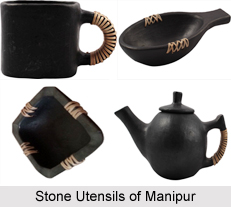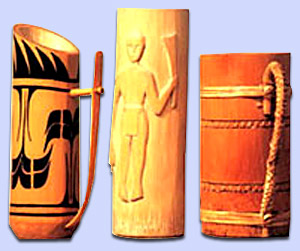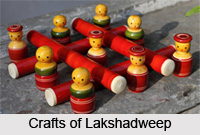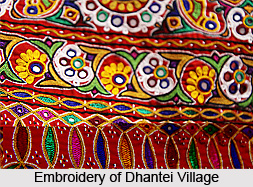 Stone has been used since ancient times for making various materials of utility and art, in India as well as all over the globe. Stone Art in India has seen its evolution from roughly made stone implements during the Stone Age to more useful and finer-finished items as civilisation progressed. The end products also in many cases, switched over to fancy items from utilitarian goods, with their type and value depending upon the type of stone used. Many historical monuments in India, the likes of Taj Mahal and Lord Jagannath temple at Puri, have been erected using stone. Stone has also been used in the construction of some 20th century monuments, such as the temples built by Birlas at Hyderabad and Kolkata. In the modern day, however, use of stone for construction purposes has diminished, except only in the case of slabs and tiles out of fancy ones. Stone edicts were prevalent during the Buddhist and pre-Buddhist eras, and they reached their prime during the reign of Emperor Ashoka. Roughly made memorial stones were raised during pre-Christian era by the Khasis of Meghalaya, still found and being worshipped. Stone Carving also developed into making of statues of deities, kings, nobles and persons of eminence. Many orthodox Hindus still believe the use of stone utensils in religious rituals as more sacred than those of any other material, reason why stone utensils are made and sold to pilgrims visiting Puri, Varanasi, Dwaraka or Rishikesh. Stone utensils, particularly those made of marble or black stone, have many advantages and cooked food can be preserved for a longer period since these stones do not react chemically. There are many stone carvers from India internationally known in the recent time.
Stone has been used since ancient times for making various materials of utility and art, in India as well as all over the globe. Stone Art in India has seen its evolution from roughly made stone implements during the Stone Age to more useful and finer-finished items as civilisation progressed. The end products also in many cases, switched over to fancy items from utilitarian goods, with their type and value depending upon the type of stone used. Many historical monuments in India, the likes of Taj Mahal and Lord Jagannath temple at Puri, have been erected using stone. Stone has also been used in the construction of some 20th century monuments, such as the temples built by Birlas at Hyderabad and Kolkata. In the modern day, however, use of stone for construction purposes has diminished, except only in the case of slabs and tiles out of fancy ones. Stone edicts were prevalent during the Buddhist and pre-Buddhist eras, and they reached their prime during the reign of Emperor Ashoka. Roughly made memorial stones were raised during pre-Christian era by the Khasis of Meghalaya, still found and being worshipped. Stone Carving also developed into making of statues of deities, kings, nobles and persons of eminence. Many orthodox Hindus still believe the use of stone utensils in religious rituals as more sacred than those of any other material, reason why stone utensils are made and sold to pilgrims visiting Puri, Varanasi, Dwaraka or Rishikesh. Stone utensils, particularly those made of marble or black stone, have many advantages and cooked food can be preserved for a longer period since these stones do not react chemically. There are many stone carvers from India internationally known in the recent time.
In the northeast Indian state of Manipur, stone worship was a traditional practice particularly during the pre-Hindu and the pre-Christian eras. Even after conversion to the new faith, these stones are still being considered sacred, either representing their ancestors or their religious deities. In Hindu tradition, the worship of Shiva Lingam or Shaligram Shila is basically stone worship, while the Jews pay respect to their ancestors by establishing stones on their graves. The Christians and the Muslims of Asia raise their graves with stone.
Even when the construction of artistic stone sculptures discontinued, the artisans remained and preserved their art for generations. Instead of erection of large buildings or images, the artisans started making miniature images and utensils as per the market demand. The art, thus, continued from generation to generation. Stone art pieces eventually became items of decor for modern drawing rooms, utensils for rituals or the often used bonsai tubs. Stone carving products therefore became a new generation products from the tradition carried forward from the Stone Age.
Manipur in itself has had the tradition of making products carved from stone since several centuries. They are produced mainly in the areas where sand stone is conveniently available. The crafty Manipuris have been carving out many useful products of stone. Scholar T. C. Hodson in his book "The Meitheis" recorded: "Stone bowls are also to be found nicely made and polished; the stone is ordinary sand stone, artificially blackened." He also noted that the household utensils comprise earthen pots manufactured for the most part by the Lois of Chairel and Shugnu villages, who also produce stone bowls carving them from the rough sandstone, which is blackened by lamp black and then finished with a high polish. While Chairel and Shugnu still remain primarily as villages of potters and villages known for distilled liquor, production of stoneware continues in Bishnupur, the headquarter of a newly formed district of same name. The varied array of products crafted by the artisans include bowls, ash trays, smoking pipes, bonsai pots etc., manufactured according to market demand, out of ash coloured sand stone with finer grain. Some of these products are artificially blackened. Traditionally, their surface used to be polished by hand with the help of rough surface but post independence, additional inputs of either power driven or hand driven grinders with emery stone are used, giving better finish.
The raw material of stone carving in Manipur, i.e., the sand stone used to be available nearby which obstructed the flow of rivers to the mighty Loktak Lake, but with the continued consumption of stone, the flow of river increased and stones today have to be procured from long distance. Thus with the passing years, stone carving and artisans are facing problems of backward linkage. There have been suggestions of forming a raw material bank for storing the local sandstone as well as better stones like granite, marble etc. after discussion with a number of artisans and a non-governmental organisation called Bishnupur District Scout Union. The suggestion, however, was discarded as not feasible to work so long as local sand stone is available free of cost even at little far off places. There is also a need to feed designs according to market feedback, which is still not done in an organised way. The artisans are only carving products out of stone as per the orders they receive, often backfiring at them. The finesse of the craft of Manipuri artisans is not properly presented, which with the same material can fetch better market if properly done. A little more inputs in designs can change the economic scenario pertaining to stone carving in the state. There is no tradition of stone carving amongst the tribes in Manipur.
Related Articles:
Stone Art, India
Crafts of Manipur
Manipur
Cane and Bamboo Crafts of Manipur
Stone Craft in India
Bishnupur, Manipur






